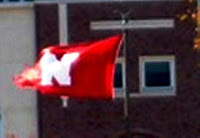With its iconic large "N," displayed on flags and buildings throughout campus...
Cornhusker football, played in Memorial Stadium, is a huge deal on campus, with the school having captured five national championships.
UNL also has an extensive visual and performing arts complex, including the Lied Center...
...the Howell Theatre...
...the Ross Media Arts Center...
...and an unusual sculpture-type display known as "Torn Notebook."
Another interesting area is by the Nebraska Union, shown outside and inside...
Just north of the Nebraska Union are the Meier Commons and Plaza...
...and the Kauffman Academic Residential Center.
Whereas all of the above buildings are situated on the main "City" campus, there's a separate East Campus about two miles away, which hosts agricultural and home economics (also known at different universities as human ecology or human sciences) programs. The East Campus includes Chase Hall (hosting Biological Systems Engineering)...
... the Entomology Building (for insect studies; formerly the "Plant Industry" Building)...
... and a nice large lawn.
The East Campus also features a Tractor Test Lab, whose tractor parades never cease to fascinate observers in the area.
Adjacent to the City Campus is downtown Lincoln, which serves as the "college town." No trip here would be complete without a visit to Husker Headquarters, featuring all the UNL sports garb and paraphernalia you could want.
Other downtown attractions include a new movie-theatre complex...
... and numerous eateries, both national-chain and those local to Lincoln.
I like to end these entries with a piece of campus trivia, if I'm aware of any. In the case of UNL, it was the host institution for the 2005 NBC "reality" show "Tommy Lee Goes to College," featuring the Motley Crue drummer. If one is willing to overlook that Lee never actually enrolled at Nebraska and that the scenarios were scripted to a considerable extent, it was a pretty good show!




















































